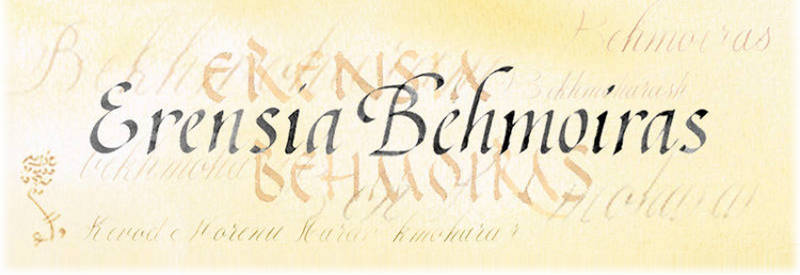The Main Line Of The Grand Rabbis
By Raphael Ventura, February 20, 2003
The sequence of grand rabbis that forms the stem of our tree is as follows:
- Menahem Bar Isaac Ashkenazi (=MENAHEM I) (1666-1734)*
- Mordehai Bekhmohar Menahem (=MORDEHAI I) (1695-1748)
- Menahem Bekhmohar Mordehai (=MENAHEM II) (1723-1781)
- Mordehai Bekhmohar Menahem (Jelibi) (=MORDEHAI II) (1745-1821)
- Menahem Bekhmohar Mordehai (=MENAHEM III) (1775-1810)
- Joseph-Raphael Bekhmohar Mordehai (Raphalanji) (1780-1849)
- Moshe-Rahamim Behmoiras (Moshonachi) son of Joseph-Raphael (1815-1878)
- Raphael Behmoiras (“The Angel Raphael”) son of Moshe-Rahamim (1837-1895)
- Meir Behmoiras son of Shabbat-Mordehai (1864-1929)
* Some of the above dates are approximate.
Numbers 1-8 held the office in unbroken sequence. Menahem III (number 5) was short-lived and childless. His younger brother, Joseph-Raphael, succeeded him. Raphael Behmoiras (number 8) had no male progeny.
After the death of Raphael Behmoiras, the entire community agreed upon a temporary rabbi, Rabbi Avraam Zemah. He remained in office for less than 10 years. Then, the sultan (Mehmet V) issued a nomination for R. Haim Bejerano from Romania, to fill the vacant seat of the late Rabbi Raphael Behmoiras. After a period of 12 years in office (1908-1919), R. Haim was transferred to Istanbul, and once again we find a member of our family as Haham Bashi of Edirne, Rabbi Meir Behmoiras son of R. Shabbat Mordehai Behmoiras (number 9). R. Meir remained in office until his death in 1929, at which time the chief rabbinate of Edirne ceased to exist.
The Gueron Dynasty ended at the closing of the 19th Century.
The grand rabbis were very learned people. Those of the Behmoiras dynasty were better versed in Biblical, Talmudic and Kabala matters, and produced many learned writings, some of which were ultimately published. The private library of the Behmoiras dynasty was famous and contained, among precious books, many unpublished manuscripts. The grand rabbis of the Gueron dynasty were more active in communal affairs and in connections with the civil government. There were two rabbinical Beit-Din institutions at Edirne headed by the grand rabbis. The Behmoiras grand rabbis were famous for their knowledgeable solutions to religious and civil cases that arose among members of their congregations. They often had to visit the Balkan communities that were under their jurisdiction, in order to settle religious and administrative questions as well as to deliver judgments.
THE PARALLEL BRANCH
After Mordechai I the family was divided into what became its two principal branches. Mordechai’s eldest son, Menahem II, inherited, as we saw, the post of grand rabbi and therefore belongs to the main branch (of the grand rabbis), whereas his second son, Solomon initiated a parallel branch, which did not produce grand rabbis, but was quite important nonetheless.
Later in his life, Solomon was given a second name: Nisim. Though he was not grand rabbi of Edirne, he was very famous for his biblical knowledge and served as a dayan of great renown. He authored important works and many letters in which he discussed halachic matters with his learned contemporaries. Solomon-Nisim died at the age of 38 in 1775.
Solomon-Nisim’s son, Simeon-Mordechai (or “Rabbi Matte Shim’on”*) visited various cities, preached and gave judgments. He died in mid life at about 1819. He had two sons: Nisim-Solomon (b. abt. 1793) and Menahem (1800-1887) whom we shall tag “Menahem IV”.
Menahem IV (or “Rabbi Divrei Menahem”*) ben Nisim-Solomon was a learned man in Talmud, excellent preacher and rabbi. People listened to his preaching in ecstasy. His renown was among Jews and non-Jews alike. His wisdom and modesty were well known. When young he was secretary in Leon Alfassa’s Bank at Edirne. His many books were burnt in the fire of 1905 in Edirne.
In 1878 he moved to Istanbul because of the Russo-Turkish war. The Jews of Edirne feared that they might suffer greatly if the Russians captured the city.
The rabbis of Istanbul received him with great honors.
In 1880 Menahem IV left for Eretz Israel and died there in 1887.
Menahem IV’s grandson was Rabbi Yomtov Behmoiram who resided in Bulgaria. He was an active Zionist leader.
* Sometimes important rabbis are commonly known by the name of their principal opus.
